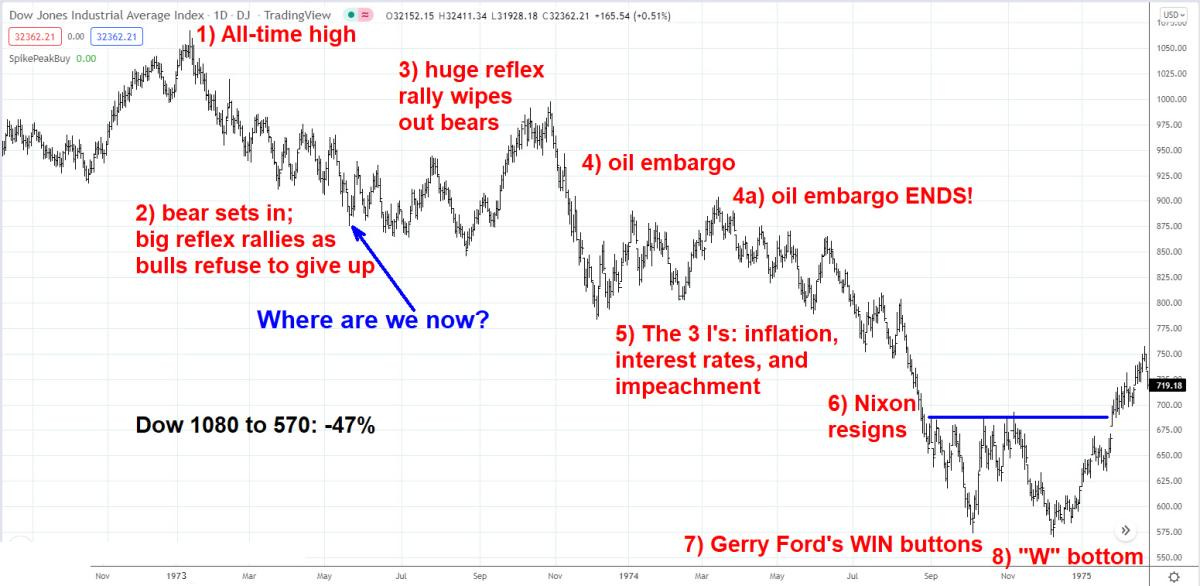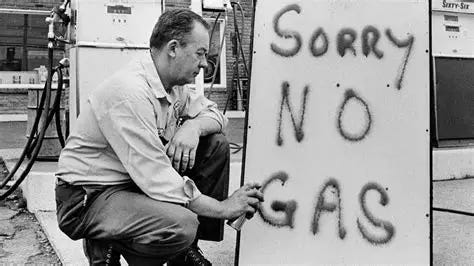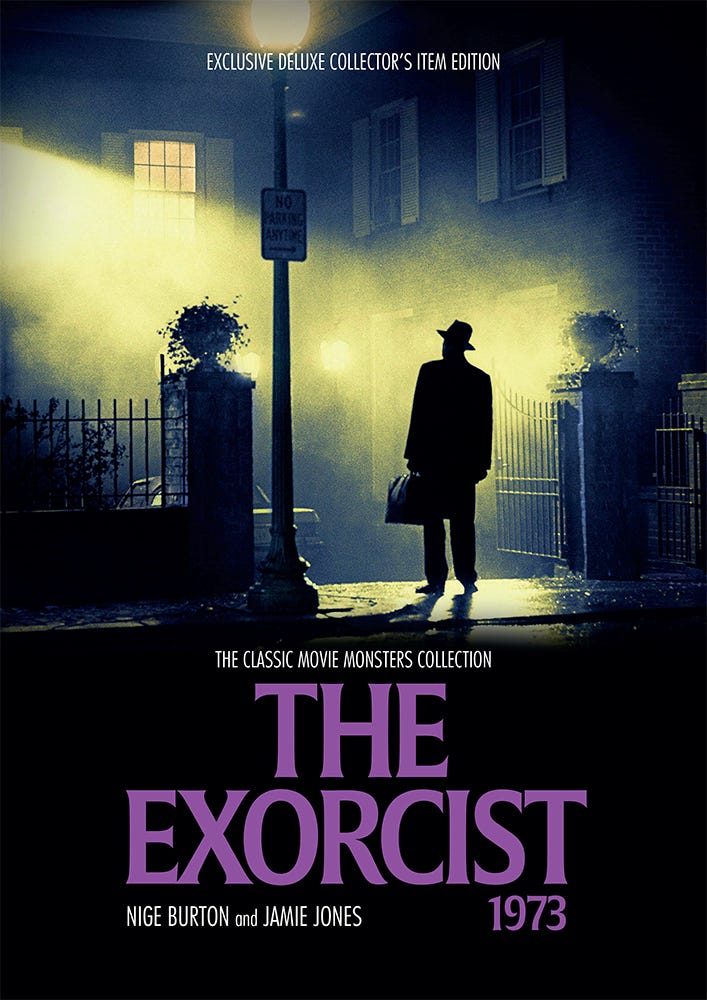1973 Berkshire Hathaway Shareholder Letter
Issue 27 | 1973 Part 5 - Inflation, Bear Market, Oil Embargo, Berkshire Hathway, Dark Side of the Moon.
1973 marked the end of an era. The postwar economic boom was fading, inflation was on the rise, and tensions were escalating in the Middle East. Oil prices were poised to quadruple, the stock market was about to experience a significant downturn, and the economy would soon enter a deep recession. The Nifty Fifty was no longer a safe bet, and investors began to run for the hills.
Backdrop
At the start of 1973, the Dow Jones Industrial Average was around 1,020. It peaked just above 1,050 in January but then tumbled throughout the year, ending at 850—marking a 17% drop that signaled the beginning of one of the worst bear markets since the Great Depression.
In March, the Bretton Woods system officially collapsed, ending fixed exchange rates and allowing major currencies, including the U.S. dollar, to float freely for the first time, ushering in a new era of global monetary volatility.
In October, the Yom Kippur War triggered a global energy crisis. OPEC nations, angered by U.S. support for Israel, cut off oil exports to the West. As a result, the price of oil quadrupled almost overnight, gas lines stretched around city blocks, and the shockwaves of this crisis rippled through every corner of the economy.
While Warren Buffett was acquiring shares in the Washington Post and Wesco Financial, Nixon was under investigation. Inflation was rising, stock prices were falling, and public trust in institutions was beginning to erode. Watergate dominated the headlines, "The Exorcist" was selling out theaters, and Pink Floyd’s "Dark Side of the Moon" played on every radio dial. Roe v. Wade had just reshaped the political landscape, the Vietnam War continued, and trust in American institutions was deteriorating.
Looking over Berkshire's brokerage activity in 1973, one has an impression of Buffett sweeping down the aisles of a gift store - here grabbing National Preso Industries, Detroit International Bridge, and on the other side Sperry & Hutchinson. On it went - U.S. Truck Lines, Munsingwear, Handy & Harman. As the market fell, he raced down the aisles all the faster - J. Walter Thompson, Coldwell Banker, Dean Witter, King's Department Stores, Morse Shoe, Ford Motors, Pic N Save, Mitchum Jones & Templeton, Grand Union, Studentbaker Worthington.1
One time, Judge John Grant, Buffett's bridge partner, mentioned that he had been having fun trying an interesting case. Buffett's eyes twinkled. "You know, he said, "some days I get up and I want to tap dance."2
1973 Shareholder Letter
Buffett began the year with his usual humility. Operating earnings reached $11.9 million, reflecting a 17.4% return on beginning equity; however, return on equity (ROE) declined from 19.8% in 1972. Why?
“The gain in earnings was not commensurate with the increase in shareholders’ investment.”3
ROE measures how effectively a company converts shareholders’ money into profits. It can be calculated as:
ROE = Profit ÷ Shareholders’ Equity
Even if profits rise, return on equity (ROE) can decrease if a company's equity increases at a faster rate than its profits. This is what occurred with Berkshire in 1973. Additionally, I believe that having the common stock portfolio underwater played a significant role in this situation.
By the end of 1973, Berkshire's portfolio, which had cost $52 million, had decreased in market value to $40 million.
Textile Operations
“Textile demand remained unusually strong throughout 1973… our main problems revolved around shortages of fiber.”4
Input costs skyrocketed. In response, Berkshire adopted LIFO (Last In, First Out) accounting:
“This method better matches current costs against current revenues and minimizes inventory ‘profits’ included in reported earnings.”
By 1973, inflation was no longer a gradual increase, it was becoming a significant issue.
Consumer prices jumped more than 6% that year, up from just 3.4% in 1972. Raw material costs surged, especially for textiles; Berkshire’s fabric costs soared due to fiber shortages. Food and fuel prices also spiked across the board. While the oil embargo would start later in the year, price shocks had already begun. Nixon’s price controls backfired, causing product shortages and creating difficulties for operators like Berkshire.
Insurance
National Indemnity had a strong year, but the insurance division overall was a mixed bag:
Regarding Texas: “In that state, we virtually had to start over during 1973, as the initial management we selected proved incapable of underwriting successfully.”5
On inflation and accident frequency: “We believe that inflation will hurt us more than reduced driving will help us.”6
Despite a challenging market, Buffett remained optimistic:
“We made substantial additional commitments in common stocks during 1973… In spite of the large unrealized loss at year-end, we expect satisfactory results from the portfolio over the longer term.”7
A $12 million unrealized loss didn’t faze him. He prioritized long-term value over short-term fluctuations.
Banking
“The Illinois National Bank & Trust Co. of Rockford again had a record year in 1973.”8
Deposits grew to $130 million, with 60% in time deposits. Buffett commended their ability to maintain profitability in a tough environment:
“We continue to maintain unusual liquidity… and we continue to sustain our unusual profitability.”9
Diversified Retailing & Blue Chip Stamps
A merger with Diversified Retailing was set to increase Berkshire’s indirect ownership in Blue Chip Stamps from 22% to 38%:
“Our holdings of stock in Blue Chip Stamps represent approximately 22¼%; implementation of the proposed merger could raise this figure to about 38%.”10
However, Buffett wasn’t particularly focused on the stamp business, he was interested in the underlying assets:
“Blue Chip’s trading stamp business has declined… but it has valuable sources of earning power in its See’s Candy Shops subsidiary as well as Wesco Financial.”
Final Thoughts
As we conclude 1973, the year was marked by rising inflation, supply shocks, and a declining stock market. However, Buffett remained active during this time. He increased his positions in Blue Chip Stamps and Wesco Financial, took a significant position in The Washington Post, and initiated positions in several other securities.
Considering all the uncertainty, Buffett had been more active than he has been in years.
Becoming Berkshire 1930-1973:
Issue 26| 1973 Part 4- Wesco Financial
Issue 25| 1973 Part 3- The Washington Post
Issue 24| 1973 Part 2 Katharine Graham - Personal History
Issue 23| 1973 Mr. Buffett Goes to Washington
Issue 22| 1972 Part 2 -The Nifty Fifty
Issue 21| 1972 - See's Candies
Issue 20| 1971 Part 3- The Nixon Shock
Issue 19| 1971 Part 2- Supermoney
Issue 18| 1971 Part 1- The Dean & The Disciple
Issue 17| 1970 Part 2 - Blue Chip Stamps
Issue 15| The Go-Go Years of the 60s
Issue 14| 1969- Part 2 Illinois National Bank
Sabre Arc Portfolio Updates:
May 2025 Review: $1,245,379.57
March 2025 Review: $1,174,370.03
December 2024 Review: $1,209,486.84
November 2024 Review: $1,214,498.45
October 2024 Review: $1,132,767
September 2024 Review: $1,137,009
August 2024 Review: $1,094,182
Lowenstein, Roger. Buffett: The Making of an American Capitalist. (New York, Random House 1995) Pg. 149.
Id.
1973 Berkshire Hathaway Shareholder Letter
Id.
Id.
Id.
Id.
Id.
Id.
Id.








